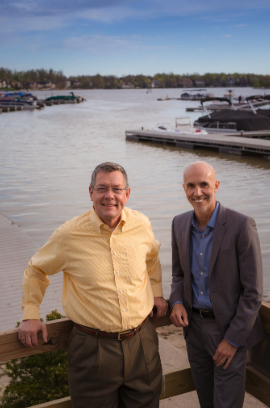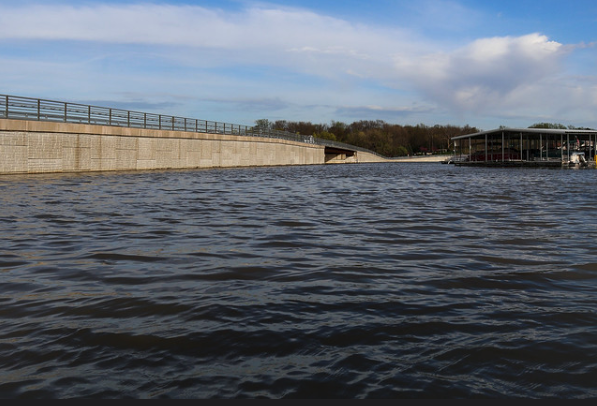Formation of Geist Conservancy District Gives Aging Reservoir Hope
Photographer: Brian Brosmer
 When it comes to the long-term health of Geist Reservoir, the days of passing the hat by the Geist Lake Coalition each year to treat the “invasive weed species du jour” are over. Heavy sediment load coming down from the Upper Fall Creek Watershed and various tributaries are filling the reservoir bottom, making it shallower with every passing day. While treating the weeds gives us some visual and nautical navigation relief, it’s only scratching the surface of the long-term needs of our area’s most valuable resource.
When it comes to the long-term health of Geist Reservoir, the days of passing the hat by the Geist Lake Coalition each year to treat the “invasive weed species du jour” are over. Heavy sediment load coming down from the Upper Fall Creek Watershed and various tributaries are filling the reservoir bottom, making it shallower with every passing day. While treating the weeds gives us some visual and nautical navigation relief, it’s only scratching the surface of the long-term needs of our area’s most valuable resource.
At the age of 75, Geist Reservoir’s health has been in a slow decline, evidenced by the blue-green algae bloom (2007), arrival of zebra mussels (2010), and most recently with the introduction of Eurasian milfoil (2013). Lucky for us, the Geist Lake Coalition was already in existence when these problems surfaced and was able to take the lead on raising the money, developing a plan and executing it effectively.
Going Toxic
Grand Lake residents in St. Mary’s, Ohio weren’t so lucky. Just across the Ohio state line, about two hours away from Geist Reservoir, Grand Lake residents had the same blue-green algae scare back in 2007 and did nothing to address the problem. They waited for someone else to come along and fix their lake. Two years later, the algae bloom went toxic rendering the lake unsafe for recreation of any kind. Shortly thereafter, the State of Ohio closed it and the lake wasn’t reopened for five years.
No boats. No fishing. No swimming. Closed.
As a result, local businesses and restaurants closed as well. Property values plummeted. To this day, even after the State of Ohio spent $32M to “fix it”, Grand Lake still has problems. Home values in the area are recovering but nowhere near where they once were.
Making the Case
A Geist Conservancy District is another layer of government, more property taxes for those living in it and new fees for those using the reservoir. It is not a perfect solution, but it is far better than the alternative: A closed reservoir.
Organizers of the Geist Conservancy District plotted out all the neighborhoods that had water frontage and drew boundaries around nearly 4,000 homes to be included in the new taxing district. With a budget of $2M per year, the new Geist Conservancy District will have the resources to control invasive weeds, buy markers and buoys, control shoreline erosion, hire staff and dredge the reservoir bottom year-round.
Most importantly, with a conservancy district, everyone who enjoys the reservoir pays their fair share of the costs: Boaters, fishermen and neighborhoods closest to the water.
Who Pays?
Several stakeholders have skin in the game, but to date, lakefront homeowners have carried the bulk of the burden to treat the algae and weed problems through contributions to the Geist Lake Coalition.
Citizens Energy Group owns the reservoir but only treats the water if the algae affects “smell or taste” of the water. Marina Limited Partnership owns the only public boat ramp, collecting an estimated $400,000 annually in boat launch fees. Indiana DNR awarded the Geist Lake Coalition a LARE grant for $5,000 in the past (which was a matching grant and a drop in the weed treatment program bucket). And while all these groups have nominally participated in clean-up efforts through donations or grants, none of them have truly taken responsibility.
Under a conservancy district, all homeowners in the district would participate financially via a special assessment each year on their property taxes. An estimate based on each home’s assessed value was posted on the Geist Lake Coalition website. These assessments would account for roughly one-half of all fees collected, with the other half coming from user fees — boat permits. This spreads the responsibility fairly to everyone who has a stake in the reservoir’s health, not just the lakefront homeowners.
Only the Surface
Many have been “stuck in the weeds” when it comes to the lake’s health, focusing only on algae and Eurasian milfoil treatments. After all, when you take up a collection annually and muster up $400,000 – that’s about all you can afford to focus on.
Under the surface, the biggest issue lurking is the depth of the reservoir and the need for year-round dredging. The Upper Fall Creek Watershed is 140,000-acres all draining down into a 6-mile long bathtub called Geist Reservoir. As sediment is carried down the watershed to the reservoir, the sediment settles to the bottom, in the main body and coves, and the water runs over the dam. Over time, the reservoir fills up with sediment and becomes shallower. Dredging is the only way to remediate sediment, and dredging is far more expensive and time-consuming than weed control.
Looking at the proposed budget created by the Geist Conservancy District organizers, less than 25% of their annual revenues would be earmarked for weeds. The bulk of the budget is allocated for dredging ($1.4M) which is currently not even being done (except for private dredging that individual neighborhoods or homeowners have contracted on their own).
 Long Term Solution
Long Term Solution
Creating a conservancy district gives homeowners around Geist Reservoir the financial means and ability to control their own destiny as it pertains to the health and preservation of Geist Reservoir. An elected board of representatives will govern the annual budget, hire personnel, commission studies, seek grants and prioritize projects.
“Thank You” Geist Lake Coalition
Originally formed as a subcommittee to the Geist Harbours Property Owners Association, the Geist Lake Coalition formed 19 years ago to address a proposed speed limit on Geist Reservoir. Hard to believe that back then our worry on Geist was the speed of boats. This all-volunteer group will most likely dissolve as the conservancy district takes over their responsibilities. Over time, they have taken on more and more issues as they have arisen, and I believe it’s time we, as a community, “thank” them.
We start this curtain call with Ed Villanyi, Scott Rodgers, Matt Huffine and Dave Irish who have faithfully served as board members for years. Beyond them, there is an entire supporting cast of volunteers, many of which became block captains in the petition drive, that hustled donations or showed up to Geist Clean Up Days. But the ringleader and visionary that has dedicated more of his time and money to Geist Reservoir than anyone is Brian Hall. He, along with Cambridge resident and attorney Matt Troyer, put this Geist Conservancy District on their shoulders and worked the murky legislative waters to bring this to fruition. Best of all, Brian doesn’t even live on the lake. He, like several thousand others within the proposed district, lives off the water with no boat dock.
Fellow residents, we finally have a structure and a plan to preserve Geist Reservoir for generations to come. It’s been a long time coming. To keep informed on the progress and next steps, follow the Geist Conservancy District Facebook page at facebook.com/geistconservancydistrict.







